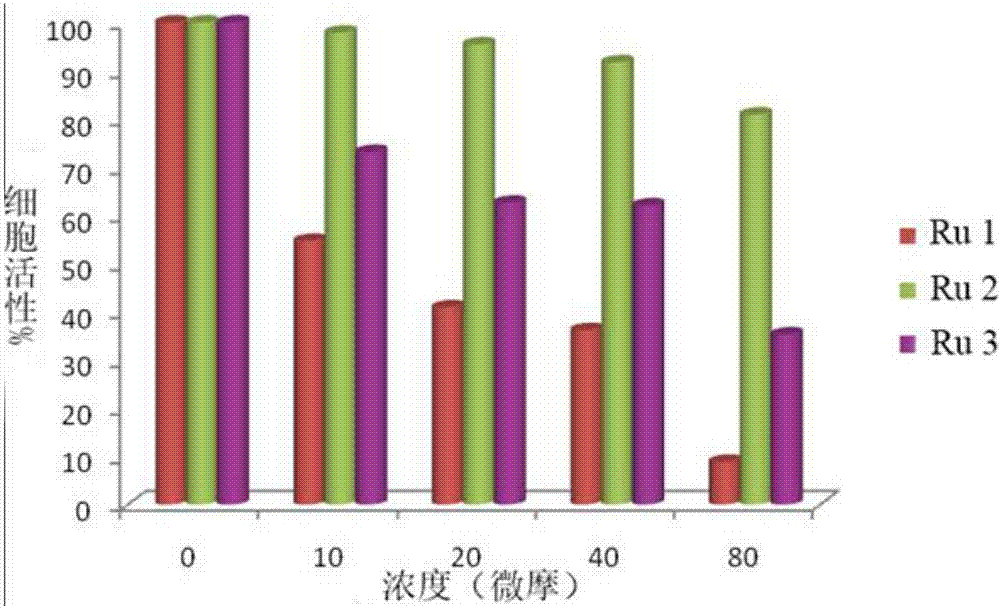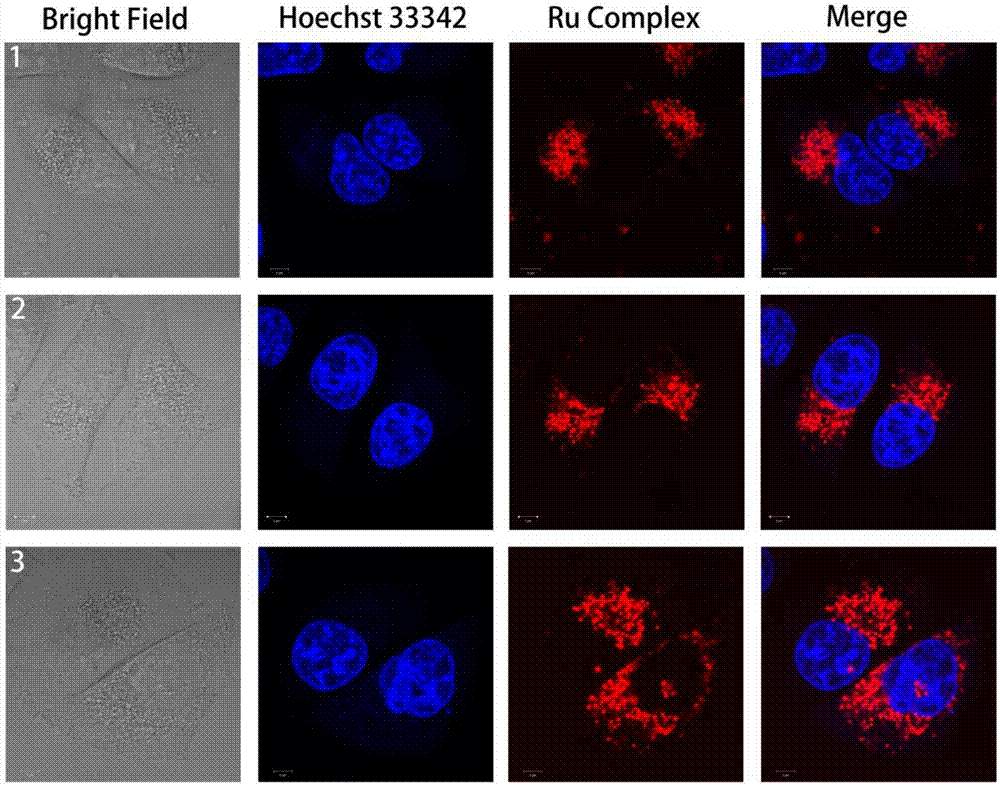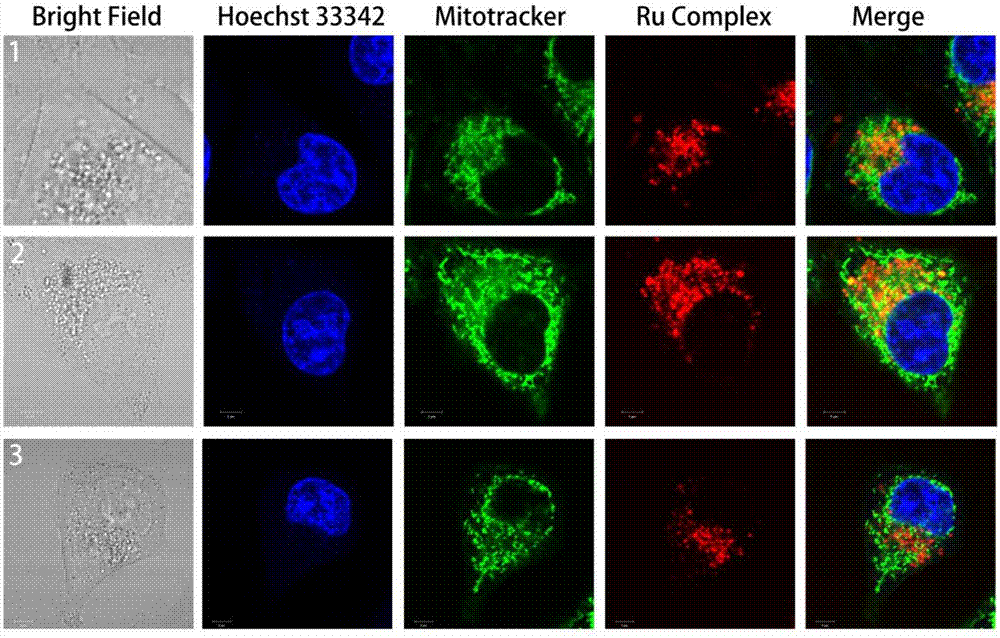Dinuclear ruthenium complexes with different alkyl chain lengths as lysosomal probes in cells
A dual-nuclear ruthenium complex and alkyl chain technology is applied in the field of fluorescent biomolecular probes to achieve the effects of long fluorescence lifetime, safe use and high sensitivity
- Summary
- Abstract
- Description
- Claims
- Application Information
AI Technical Summary
Problems solved by technology
Method used
Image
Examples
Embodiment 1
[0014] Embodiment 1: the preparation of ligand L1, L2, L3 and three ruthenium complexes
[0015] 1. Preparation of precursors: 1,3-bis-(4-formyl-carbazolyl)propane, 1,6-bis-(4-formyl-carbazolyl)hexane, 1,10-di- References for the synthesis of (4-formyl-carbazolyl)decane (Zhang Yuqi, master thesis of Beijing Normal University; Zhang, Y.; Wada, T. and Sasabe, H. Joμrnal of Polymer Science: Part A: Polymer Chemistry. 1996, 34, 2289-2298; Ostraμskaite, J.; Voska, V. and Grazμleviciμs, J.V. Monatshefte für Chemie. 2002, 133, 599-607.).
[0016] 2.1,10-Phenanthroline-5,6-dione synthesis: combining the advantages of various literature methods, (Amouyal, E.; Homsi, A.; Chambron, J.-C. and Sauvage, J. -P.J.Chem.Soc., Dalton Trans.1990,1841-1845; Hiort,C.; Lincoln,P.and Nordén,B.J.Am.Chem.Soc.1993,115,3448-3454;Paw,W.and Eisenberg, R.Inorg.Chem.1997,36,2287-2293.; Calderazzo,F.; Marchetti,F.; Pampaloni,G.and Passarelli,V.J.Chem.Soc.,Dalton Trans.1999,4389-4396) before the experiment s...
Embodiment 2
[0023] Embodiment 2: Cytotoxicity experiment of three ruthenium complexes
[0024] Take cervical cancer HeLa cells that are in the exponential growth phase, make cell suspension with culture medium, and count with a cell counting plate, according to 1×10 4 Cells / well were seeded in 96-well plates for subculture. After 24 hours of cell passage, the original medium was aspirated, and 100 microliters / well of medium containing different concentrations of ruthenium complexes (10-80 micromolar) was added, and 100 μl / well of medium containing different concentrations of cisplatin complexes was added to the positive control group. 100 microliters / well of fresh culture medium was added to the negative control group. Place the 96-well plate in an incubator with 95% relative humidity and 5% carbon dioxide at 37°C for 24 hours. After 24 hours of complex action, discard the old medium, and add 100 microliters of MTT-containing medium (5 mg / ml MTT:medium = 1:10) in the dark; incubate for ...
Embodiment 3
[0025] Example 3: Fluorescence confocal localization experiment of three complexes in HeLa cells
[0026] The cells were seeded in a 20 mm2 petri dish for fluorescence confocal microscopy with a cell density of 1.0×10 4 Each / well, add a medium with a fixed concentration of ruthenium complex Ru2 (20 micromolar), put it into a 37° C. relative humidity of 95%, and incubate with a 5% carbon dioxide incubator for 24 hours, suck out the original medium, and use pH=7.4 The phosphate solution was washed three times, stained with LysoGreen at a concentration of 10 micromolar for 2 hours, 100 nanomolar of mitochondrial dye Mito-Tracker Green for 30 minutes, and nuclear dye Hoechst 33342 at a concentration of 5 micromolar for 30 minutes. Complexes were imaged under a ZEISS LSM700 confocal microscope with an Ar / Kr ion emitter excited at 488 nm. The colocalization results of Ru2 with Hoechst 33342, (Hoechst33342 and Mito-Tracker Green), (Hoechst 33342 and LysoGreen) are shown in figure ...
PUM
 Login to View More
Login to View More Abstract
Description
Claims
Application Information
 Login to View More
Login to View More - R&D Engineer
- R&D Manager
- IP Professional
- Industry Leading Data Capabilities
- Powerful AI technology
- Patent DNA Extraction
Browse by: Latest US Patents, China's latest patents, Technical Efficacy Thesaurus, Application Domain, Technology Topic, Popular Technical Reports.
© 2024 PatSnap. All rights reserved.Legal|Privacy policy|Modern Slavery Act Transparency Statement|Sitemap|About US| Contact US: help@patsnap.com










